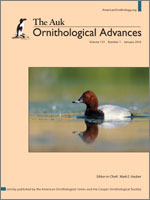Population age structure is important for understanding population dynamics, but can be difficult to resolve in landbirds due to the limited number of age classes discernible by examining plumage. In forests of western North America, Black-backed Woodpeckers (Picoides articus) typically colonize burned areas shortly after fire, but densities decline within 6–10 yr. This pattern is often assumed to result from adult Black-backed Woodpeckers abandoning territories when food resources wane, yet long-distance breeding dispersal is relatively rare in birds, whereas long-distance natal dispersal is more common. To determine whether colonization of newly burned areas is driven primarily by breeding dispersal of adults or natal dispersal by young birds, we captured 57 adult Black-backed Woodpeckers in 6 burned areas in California between 1 and 8 yr after fire. We used patterns of multiple feather generations retained among primary coverts, secondaries, and secondary coverts to assign birds to 1 of 5 age classes (second-, third-, and fourth-calendar-year; after-third-calendar-year; and after-fourth-calendar-year). Population age structure varied dramatically across burned areas, with a preponderance of second-calendar-year birds in the 1 yr and 2 yr postfire areas, and a preponderance of birds at least 3 yr old in the older postfire areas. Poisson generalized linear mixed models (GLMMs) revealed that the effect of years since fire on woodpecker age was highly significant (z = 3.575, P < 0.001). Our results indicate that natal dispersal is the primary means by which Black-backed Woodpeckers colonize recently burned areas in western forests, and that breeding dispersal is uncommon. The decline of Black-backed Woodpecker populations 6–10 yr after fire likely reflects the lifespan of individual birds that colonized the burned area, or of offspring that they produced in the early postfire years. Our discrimination of Black-backed Woodpeckers into 5 age classes confirms previous suppositions about plumage-based age determination in woodpeckers, and is likely applicable to other woodpecker species.
How to translate text using browser tools
16 December 2015
Age structure of Black-backed Woodpecker populations in burned forests
Rodney B. Siegel,
Morgan W. Tingley,
Robert L. Wilkerson,
Christine A. Howell,
Matthew Johnson,
Peter Pyle
ACCESS THE FULL ARTICLE

The Auk
Vol. 133 • No. 1
January 2016
Vol. 133 • No. 1
January 2016
Black-backed Woodpecker
breeding dispersal
molt
natal dispersal
Picoides arcticus
population age structure




